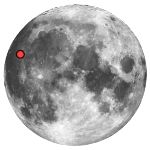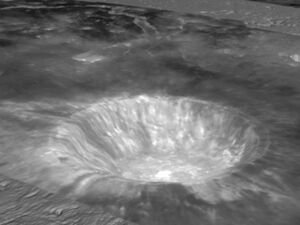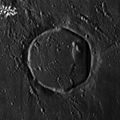Aristarchus (crater) facts for kids

Aristarchus is a very large crater on the Moon. It was formed when something big, like an asteroid, crashed into the Moon. This crater is about 40 kilometers (25 miles) wide. You can even see it from Earth without a telescope! It looks like a bright spot on the Moon's surface. The crater is named after a famous Greek astronomer named Aristarchus of Samos.
Contents
Where is Aristarchus?

Aristarchus is found on a high, rocky area called the Aristarchus Plateau. This plateau is in the middle of a huge flat area on the Moon called the Oceanus Procellarum. This flat area is like a big, dark plain made of old lava.
The plateau itself is a tilted block of the Moon's crust. It is about 200 kilometers (124 miles) wide. In some places, it rises up to 2 kilometers (1.2 miles) above the surrounding plains. Aristarchus is next to another crater called Herodotus. It is also near a long, winding valley called the Vallis Schröteri. There are also many small, winding channels nearby called Rimae Aristarchus.
Why is Aristarchus so Bright?
Aristarchus looks very bright because it is quite young. It formed about 450 million years ago. Over time, the Sun's energy and tiny particles from space can darken the Moon's surface. But Aristarchus hasn't been exposed to these for as long as older craters. So, the material dug up by the impact is still very bright.
The impact that made Aristarchus happened after the crater Copernicus formed. But it was before the crater Tycho appeared. Because Aristarchus has bright streaks, called "rays," spreading out from it, scientists know it's a relatively new crater.
The brightest part of the crater is its tall central peak. This peak is in the middle of the crater. The floor of the crater looks flat in some places. But pictures from spacecraft show it has many small hills. It also has long scratches and tiny cracks.
The outer wall of the crater is shaped a bit like a polygon. It has many steps, like terraces. This wall is covered in a bright blanket of material thrown out by the impact. These bright materials spread out into long rays, especially to the south and southeast. This suggests that the object that formed Aristarchus hit the Moon from the northeast.
In 2011, a spacecraft called the Lunar Reconnaissance Orbiter flew over the crater. Scientists took many pictures. They said the Aristarchus plateau is one of the most interesting places on the Moon. It has a mysterious raised plateau and a giant valley carved by lava. It also has areas of volcanic ash. All of this is surrounded by huge lava flows.
Studying Aristarchus from Afar
Scientists use special tools to study the Moon from Earth or from spacecraft. This is called remote sensing.
In 1911, a scientist named Robert W. Wood took pictures of the crater using ultraviolet light. He noticed that the plateau looked unusual in ultraviolet. He also thought an area to the north might have sulfur. This colorful area is sometimes called "Wood's Spot."

During the Clementine mission, scientists used special tools to map the minerals in the crater. They found that the central peak is made of a rock called anorthosite. This rock forms slowly from hot liquid rock. It is mostly made of a mineral called plagioclase feldspar. The outer wall of the crater is made of a different rock called troctolite. This rock has equal amounts of plagioclase and olivine.
In 2005, the Hubble Space Telescope also studied the Aristarchus region. Scientists were looking for glassy soils rich in oxygen. They were especially looking for a mineral called ilmenite. They compared Aristarchus to places where Apollo 15 and Apollo 17 landed. At those landing sites, scientists already knew what the rocks were made of.
The Hubble telescope found that Aristarchus has a lot of ilmenite. This mineral is a titanium oxide. In the future, people living on the Moon might be able to use ilmenite to get oxygen. This oxygen could be used for breathing or for rocket fuel.
Images for kids
See also
 In Spanish: Aristarco (cráter) para niños
In Spanish: Aristarco (cráter) para niños






